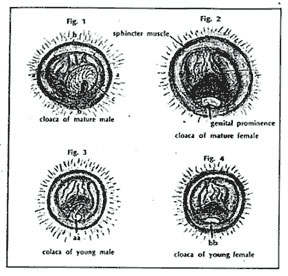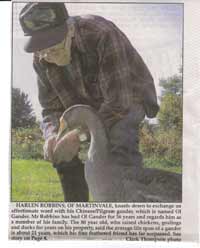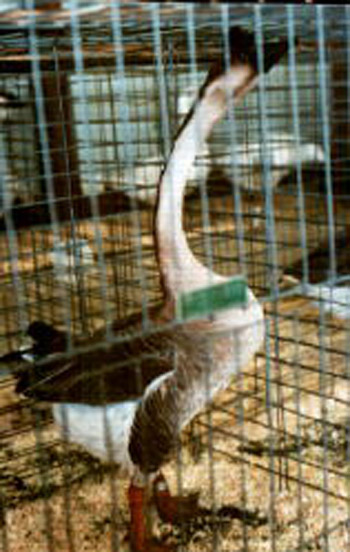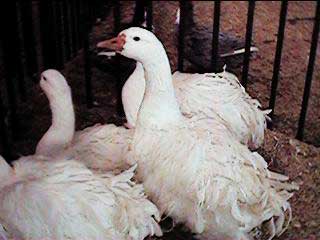 |

|
Currently there are no events or updates to display. |

Geese: The Basics First things first. Most breeds of domestic geese are descended from the wild Gray Lag goose (Anser anser) of Europe. The Chinas and Africans trace their ancestry back to the Asian Swan Goose (Anser cygnoides). The Canada (Branta canadensis) is not a true goose in the technical sense but is a member of the Brant family. There are a number of subspecies of Canada and it is probable that most have interbred and are no longer 100% pure. You need to know that the APA Standard description for the Canada is based upon the Eastern Canada and if one shows another type which differs markedly from the Eastern subspecies such as the Cackler or Giant Canada, a knowledgeable judge will not place it highly. The Egyptian goose is another species that is still found today in the wild in Africa and it also is not a true goose but a member of the Sheldrake family. It's closest relative appears to be the Muscovy duck. The bottom line is that in spite of the classification differences mentioned above, the Canada, Egyptian, and all of the true geese are to be found in the APA Standard of Perfection in the goose category. Most geese share a number of common characteristics. They are grazers and can obtain a large part of their livings from grasses and other vegetation. They generally will prefer to mate in pairs (some breeds will readily be mated in trios or even four females to a male). As a general rule, the light breeds of geese (with the exceptions of the Canadas and Eygptians) will be more likely to accept multiple females. Once those matings are established, they will endure until one mate dies or until the mating is broken up. Geese can normally be relied upon to hatch and rear their own young in the right situations. Usually, the ganders share in that task by guarding the nest while their mates incubate the eggs and by assisting in watching over the growing goslings. Both parents may be expected to defend the young whether the threat comes from a predator or from their owner, and make no mistake; geese can deliver powerful blows with their wings. Usually, the breeding season is the only time of year when most geese show any real signs of being aggressive, despite their large size. Geese tend to be much more difficult to sex visually than ducks for those inexperienced with them and even a veteran can be fooled by an extra large and masculine looking female or by a small, refined male. There are some differences in the voices but behavior tends to be a more reliable gender tip-off. When the flock is approached by a stranger, the ganders usually will position themselves between the females and the "threat" and will warn the intruder with outstretched necks and hissing sounds. Probably, the easiest geese to sex on sight are, of course, the auto sexed Pilgrims, the Chinas, and the Egyptians. The only 100% accurate way to sex geese is through vent sexing (see illustration) which involves examination of the genitals. The process is best left to someone with some experience since it is quite easy to apply too much pressure and in so doing to cause injury. Vent sexing can be performed on geese or ducks from one day of age to full grown adults. Illustration of male and female sex organs in waterfowl Most geese cannot fly well ( notable exceptions: Canadas, and Egyptians) and can generally be contained by a four foot high fence. The fence should be tight enough, however, to protect them from predators such as coyotes and packs of dogs which can prey on even the largest of the geese. Smaller breeds and goslings of all breeds are vulnerable to a much wider array of predators including raccoons. Geese are quite hardy and need nothing more than a shed open to the south well bedded with straw even in the upper Midwest. They do need a steady source of clean, unfrozen water in cold temperatures to keep them from dehydrating. Geese do not suffer from many health problems and can be quite long lived. There have been reports of geese attaining an age of over 100 years but frankly, I find that hard to believe. I know from personal experience, however, that they can live to 25 years of age or more when cared for properly.
Several breeds were developed in specific farm regions in Europe to cater to the local market. Some breeds have names which allude to the region in which they were developed or to the port city from which they were exported. Geese come in a wide range of sizes from the massive Embdens and Toulouse to the diminutive Eygptians. Embden ganders from exhibition strains routinely tip the scales at 30 lbs. or more when several years of age. Full-grown Egyptian ganders rarely weigh much over 5 lbs. As previously mentioned, many of the large breeds were developed to fill the local demand for a large table fowl. The Chinas, on the other hand have been used as a source of a leaner and smaller fowl for the table as well as for "weeders" in commercial agriculture and as "watch geese" since they are active, noisy and very sensitive to the presence of strangers. A Brown China gander at a show. His well arched neck, short back, and refinement are signs of his qualities as a fine showbird. While the Sebastopol (see illustration) was bred primarily primarily for it's unusual and ornamental curled plumage, the sex linked Pilgrim was refined as a medium sized market goose. It has the added advantage that the sexes are easy to determine visually from day old gosling to mature adult because males are white with blue eyes and females are gray with brown eyes.
It is generally agreed that the Embdens are the largest breed in terms of producing the largest individual specimens. An equally impressive breed with a totally different temperment and conformation is the Toulouse, which is now standardized in the original gray and the more recently developed buff color patterns. Toulouse are generally much less active than the Embden. They are easily confined by even 24 inch high fencing. Frequently Asked Questions About Geese Q. How many Standardized breeds of geese are there? A. At present, there are 11 breeds of geese recognized by the American Poultry Association in it's Standard of Perfection. There are a total to 15 varieties within those breeds. Keep in mind that standardization is an ongoing process and that new varieties in particular are introduced periodically. Q. What is the incubation period for goose eggs? A. The incubation period varies from about 28 days to over 30 days depending upon the breed and incubation conditions. Q. What are the best ways to get started with geese? A. One can begin with a grown pair, some mature young birds, with goslings, or hatching eggs. I recommend buying hatching eggs only if one can be assured that the eggs are fresh. Avoid shipment of hatching eggs if possible. Before purchasing breeding stock or goslings, research the reputation of the seller to assure that good quality stock is being obtained. Poor stock is not a bargain at any price. The worst place to buy any type of quality poultry is the so-called swap meet. 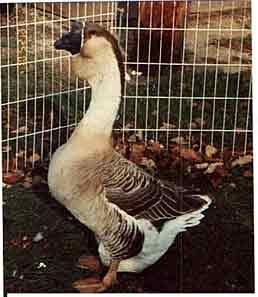 An African Gander Q. Can you recommend a source of quality stock or goslings? A. While there are a number of sources of quality stock, I feel comfortable recommending one particular source: Dave Holderread of Corvallis, Oregon. He and his wife Millie sell goslings and adult stock in most breeds and they give good quality for the money. You can ask for a price list by contacting them at PO Box 492 Corvallis, Or. 97339 Q. What do geese eat? A. Good pasture will supply them with most of what they need. If one does not have pasture available year round, geese can do well on mixed whole grains supplemented with a good quality waterfowl breeder pellet just before and during the breeding season. Q. Does one need a pond to raise geese? A. While having a clean pond will certainly make keeping geese easier for you and nicer for the birds, many successful breeders keep and breed them without anything more than plastic pools or other artificial "ponds". Q. What is the most common mistake made by new raisers of geese? A. Probably over feeding the geese- especially too much corn in their diets. Over fat geese will generally not breed well and over fat females will often "blow out" during the breeding season which makes them useless for either breeding or show. Originally published: 04-10-2001 |
Copyright © 1997 - 2025 Acorn Hollow Bantams. All Rights Reserved. | Terms of Use | Privacy Policy

